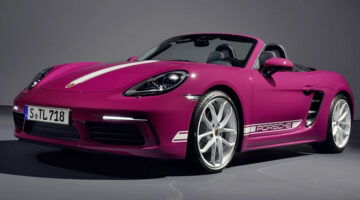| Beautifully balanced chassis and well considered ergonomics | |
| Coarse, lumpy engine, made even worse by the memory of its predecessor |
Since its launch in 2005 the Porsche Cayman slowly established itself as a genuine Porsche sports car. Every iteration and improvement helped it become more than just a car for those who couldn’t afford a 911, until now.
The latest change to the Cayman has not only bought about a new name, but its naturally aspirated six-cylinder motor, one of the highlights of the old car, has been replaced by a turbocharged flat-four – a 2-litre for the basic car and a 2.5-litre for the S and GTS.
The new engine, to no surprise, doesn’t have the same loveable character, captivating noise or apparent quality as the old unit. And so the new 718 Cayman, along with its close relative the 718 Boxster, has become the go-to car to illustrate the horrors of the industry trend for downsized turbocharged engines.
It’s certainly not all bad, though. The four-cylinder engine may be less than appealing, but it still hasn’t ruined the Cayman and there’s plenty to enjoy behind the wheel. Its small proportions make it an excellent fit for regional roads while its sublime chassis, and perfectly weighted controls mean it’s always enjoyable.
The 718 GTS, like the Carrera GTS and Macan GTS, is the pick of the Cayman range – especially when fitted with the slick six-speed manual gearbox. With 360bhp (15bhp more than the S), a torque-vectoring differential and adaptive dampers as standard it’s not only the fastest and most complex Cayman you can currently buy, it’s also the most exciting.
Porsche 718 Cayman in detail
Performance and 0-100kph time – Both the standard Cayman and Cayman S are usefully quicker than their naturally-aspirated predecessors, with 0-100kph times as low as 4.2 seconds for a PDK, Sport Chrono equipped S.
Engine and gearbox – The source of much controversy, Porsche’s new flat-four turbo engine has its critics. Unfortunately no matter which model you go for, the Cayman is resolutely a turbo-only zone.
Ride and Handling – Thanks to a near perfect weight distribution – 46/54 front to rear – the Cayman’s dynamic ability is stronger than ever. Grip is substantial, but more impressively, the handling balance is entirely transparent, a feat not replicated in rivals.
KPH and running costs – With the rationale behind the contentious new engines based on improved efficiency, you would hope the new Cayman would improve its figures. And it does, but only on paper.
Interior and tech – Undoubtedly well constructed and ergonomically sound, the Cayman’s cabin is starting to show its age against rivals like the Audi TT.

Prices, specs and rivals
For its 2016 update, the Porsche 718 Cayman went through quite a significant mechanical change. It lost its naturally aspirated flat-six engine, gained a new name and replaced the Boxster as the cheapest car in Porsche’s model range.
Now coming under the 718 moniker, that it shares with the Boxster, both the Cayman and Cayman S have relinquished their lovely naturally aspirated flat sixes for a pair of turbocharged flat-4 engines with 2- and 2.5-litre capacities, respectively.
Paired with 6-speed manual or 7-speed PDK dual-clutch gearboxes, the new 718 for the first time shares its outputs with the Boxster. That means it now undercuts the convertible on price but, unlike the old naturally aspirated Cayman, it’s no more powerful than the Boxster.
In addition to these changes, Porsche has updated the interior with a new infotainment system based on the 911’s as well as new LED lighting. The styling has been subtly updated and the chassis has been revised, taking into account the new engine’s characteristics.
Starting at $57,220, the basic Cayman with a manual gearbox sounds like exceptional value, but thanks to a stark standard equipment list it is easy for the price to skyrocket through expensive yet sometimes essential options.
The few notable additions to the standard kit list are Porsche’s new PCM touchscreen infotainment system and Bi-Xenon headlights, both of which were added for the first time with the 718 update.
If you want Porsche’s PDK gearbox, one of the best dual-clutch transmissions available, it will set you back an additional $2563. The Sport Chrono pack ($1695), Porsche Torque Vectoring ($1235) and Sport suspension with Porsche Active Suspension Management ($1572) are other tempting options.
The GTS comes with these desirable options, as standard as well as an extra 15bhp and 7lb ft of torque, 20-inch wheels and black styling cues. It does, however, cost $10,688 more than an S at $79,855.
The basic Cayman competes with the dynamically inferior Audi TT S ($53,776) and BMW M240i ($47,245), although to match those cars on kit, one must dip rather heavily into the options list.
If you want an ‘S’ you’ll have to part with $65,140, again needing to spend extra on the above options. At this price the Cayman takes on the incredibly quick TT RS ($69,000), the lithe Alpine A110 ($69,103) and brutish BMW M2 ($58798).
All four cars have their own appeal, and each perform the task of performance coupe in a very different manner. The Cayman, however, with its wonderfully balanced chassis, is the best $67,000 coupe on offer – even if its engine leaves a lot to be desired.
The more powerful and more expensive GTS gets dangerously close to more potent rivals from BMW and Jaguar. The BMW M4 is cheaper than the Porsche, is more practical as it has two extra seats and, with 425bhp, it’s significantly more powerful. Yet still, even at this price, the M4 doesn’t exhibit such a nuanced and immersive chassis as the 718 Cayman.



